The Barriers to Overcome
“The main problem with running on 100% renewable energy is that much of it is intermittent. The sun only shines during the day and the wind isn't always blowing, and these are the two main sources of renewable energy. The technology to generate electricity with renewable resources like wind and solar has existed for decades, but technologies like long duration battery storage and transmission lines would need to be scaled up dramatically. There would also have to be profound cultural and political shifts with an eye toward solving tomorrow’s problems, instead of maintaining the status quo.”
Source: carbontracker.org, CNBC clean energy
“Nuclear reactors supply steady, low-carbon energy—a valuable commodity in a world confronting climate change. But, past nuclear accidents has created widespread concerns. Environmental groups, fearful of nuclear meltdowns and weapon proliferation, began lobbying governments to stop building new power plants. In the US, the result was rafts of new safety regulations that made building and operating plants two to three times more costly. In addition, building new plants can take decades.
Nuclear power also has significant waste risk, Consumed fuel rods from nuclear plants are radioactive waste. Most fuel rods are stored at the same site as the reactor that consumed them. This has given rise to hundreds of radioactive waste sites in many countries that must be maintained and funded for at least 200,000 years, far beyond the lifetimes of any nuclear power plant. The more nuclear waste that accumulates, the greater the risk of radioactive leaks, which can damage water supply, crops, animals, and humans.”
Source: EU.boell.org
“While Europe is far more densely built and Asian cities have centered their growth around massive urban rail networks, most American living is car dependent. The widespread failure of American mass transit is due to cheap gas and suburban sprawl. Post-World war urban transport strategies have prioritized cars and traffic speed flows. Instead, cities should prioritize the movement of people, giving residents and visitors a wider variety of attractive transport options.
Shifting private vehicles to more sustainable modes of transport is essential for reducing urban greenhouse gas emissions. Cities can use a mix of incentives and disincentives to promote this shift in the short to medium term, and implement transit-oriented development to achieve a larger modal shift in the longer term.
A few approaches include 1) Discourage Private Car Use Through Road Pricing, and Driving and Parking Restrictions 2) Promote Sustainable Travel Choices Through Positive Marketing and Personal Stories 3) Implement Transit-Oriented urban Development around mass transit - streetscape alterations for walking, cycling and priority bus lanes, marketing campaigns and car-free days.”
Source: Citychangers.org
About 2 billion EVs need to be on the road by 2050 for the world to hit net zero, but sales stood at just around ~10M vehicles globally in 2022. The path ahead for widespread EV adoption still has some challenges.
Limited access to charging infrastructure: A lack of public charging infrastructure is the main barrier to EV adoption globally.
Range anxiety: worries about the distance an EV can travel on a single charge – is another main barrier to electric vehicle adoption. Around a third of drivers from around the world say they are concerned about driving long distances in electric-powered cars
Grid Overload: Power grids are already strained as we deal with a greater RE share and the challenge of more intermittent energy supply. Increased adoption of EVs adds further electricity load, potentially requiring new investment in grid infrastructure to meet this increased demand
Supply shortages of critical minerals and rare earth metals: EVs use about six times more mineral inputs than ICE vehicles. The IEA’s forecast of 70 million EVs on the road by 2040 will be accompanied by a 30-fold increase in demand for minerals. There is no shortage of these resources underground, but rather a concern as to whether they will be extracted sustainably, in line with social responsibility governance, and in time to meet demand. It is anticipated that there will be a shortage of nickel and challenges in scaling up lithium production.
The world could face lithium shortages by 2025, while demand could treble between 2020 and 2025. Lithium supply faces challenges not only from surging demand, but because resources are concentrated in a few places and over half of today’s production is in areas with high water stress.
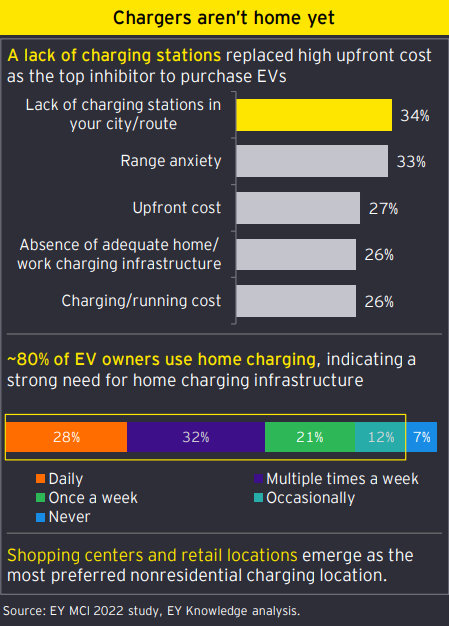
Source: IEA, weforum.org
Yes, “Transportation is already one of the world’s biggest sources of greenhouse gases, and its emissions are predicted to grow. A major reason is freight: the planes, trains, trucks, cargo ships, and other vehicles used to move billions of tons of cargo around the world. Freight transportation makes up 8% of global greenhouse gas emissions and its carbon emissions may double by 2050.
Even though most of the world’s cargo travels by sea, diesel powered trucks have an outsized impact on carbon emissions: road freight emits more than 100 times as much CO2 as a cargo ship to carry the same amount of stuff the same distance. And road freight is growing quickly, in part because of the rise of e-commerce, which has accelerated the number of packages delivered to homes. Battery-electric power, are not practical for huge vehicles like airplanes and cargo ships, but can power last mile road vehicles traveling shorter distances within a city. Electrification of trucks is still nascent and high cost of fleet upgrades by truck operators will remain a barrier for faster adoption. “
“On the other hand, About 90% of the world's trade is transported by sea. But the cost to the environment is enormous. Every year, those container ships plying the world's waterways spew about 1 billion metric tons of carbon dioxide into the air, which is about three 3% of all greenhouse gas emissions. Today’s ships run on heavy fuel oil. The key to reducing emissions will be to use carbon neutral, or green, fuel. But that hasn't been developed yet, at least not on a commercial scale. And new ships are both expensive and still designed to run on oil.”
Source: MIT climate portal, NPR
Industry has been promoting hydrogen as a reliable, next-generation fuel to power cars, heat homes and generate electricity. Most hydrogen used today is extracted from natural gas in a process that requires a lot of energy and emits vast amounts of carbon dioxide. Producing natural gas also releases methane, a particularly potent greenhouse gas.
While many experts agree that hydrogen could eventually play a role in energy storage or powering certain types of transportation — such as aircraft or long-haul trucks, where switching to battery-electric power may be challenging — there is an emerging consensus that a wider hydrogen economy that relies on natural gas could be damaging to the climate and remains expensive at current costs.
Source: Cornell and Stanford energy research
Carbon offsets occur when a polluting company, government or individual buys a carbon credit to make up for the greenhouse gas it has emitted. The money should be used to fund action somewhere in the world that remove the same amount of carbon out of the air, or to prevent carbon emissions. Typical projects include protecting forests, providing people with fossil fuel alternatives, or averting emissions from waste.
If done properly, carbon offsets can help channel funds to conservation and sustainable development projects that will reduce emissions, giving companies time to work towards zero emissions. However, poor execution thus far has made this a greenwashing effort, allowing companies to avoid cutting their emissions while still being able to claim they are, or will be, carbon neutral.
Source: weforum.org
Fossil subsidies are intended to protect consumers by keeping prices low, but they come at a high cost in the form of accelerating climate change. Globally, fossil fuel subsidies were $5.9 trillion or 6.8 percent of GDP in 2020 and are expected to increase to 7.4 percent of GDP in 2025 as the share of fuel consumption in emerging markets (where price gaps are generally larger) continues to climb.
Raising fuel prices to their fully efficient levels reduces projected global fossil fuel CO2 emissions 36 percent below baseline levels in 2025—or 32 percent below 2018 emissions. At COP26 in 2021, 197 countries agreed to accelerate efforts to phase-out inefficient fossil fuel subsidies.
Despite the potential gains, many countries have had difficulty reforming subsidies. When reforms are made, prices increase, and this has often led to widespread public protests. Governments are also often concerned that higher energy prices will contribute to a higher rate of inflation and adversely affect their competitiveness.
Source: IMF
A carbon tax is a fee imposed on the burning of carbon-based fuels (coal, oil, gas). A carbon tax is an approach to have users of carbon fuels pay for the climate damage caused by releasing carbon dioxide into the atmosphere. If set high enough, it becomes a powerful monetary disincentive that motivates switches to clean energy across the economy, simply by making it more economically rewarding to move to non-carbon fuels and energy efficiency.
A number of countries, regions, and local governments around the world have a carbon tax or a something similar like an energy tax related to carbon content. As of 2021, 35 carbon tax programs have been implemented across the world. Many economists have proposed that carbon taxes are the most efficient (lowest cost) way to tackle climate change. Largest emitters such united states and india are still not effectively using these to tackle climate change.
Climate change’s economic toll — known as the “social cost of carbon” is estimated at $185 per ton of CO2 emissions. An average person in the US emits 16 tons of carbon per year. An appropriate carbon tax will be $2,960.
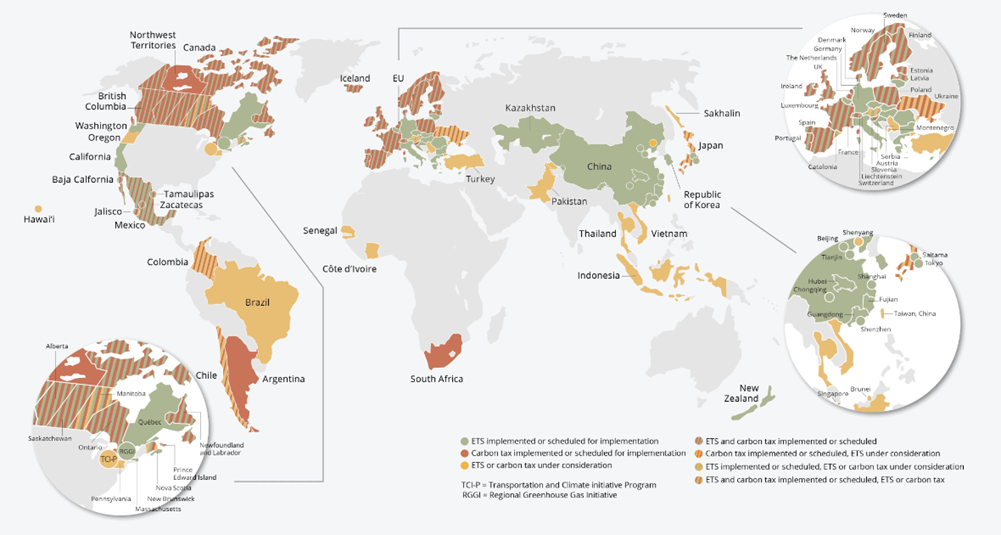 Source: carbontax.org, brookings.edu
Source: carbontax.org, brookings.edu
“The Green Premium is the additional cost of choosing a clean technology over one that emits more greenhouse gases. Right now, clean solutions are usually more expensive than high-emissions ones, in part because we don’t factor the true economic and environmental costs of existing options like fossil fuels into the price we pay for them. A plant based burger is more expensive than ground beef, cleaner forms of cement production is more expensive than cement production with fossil fuels.
There are a few ways to lower Green Premiums and make the transition to zero.
Governments can implement public policies that make carbon-based technologies more expensive, or make the clean counterparts cheaper—or, ideally, do both. These policies can include rules about how much carbon a technology can emit, regulations that shape financial markets, and public investments in R&D.
Companies and investors, meanwhile, can commit to buying cleaner alternatives to help drive their costs down, investing in R&D, supporting clean energy startups, and advocating for government policies that bring down the cost of getting to zero.
Individuals can play a role, too. We can hold our elected officials accountable, and we can vote with our wallets. For example, when we buy an electric vehicle even though it may cost more, we show there is demand for these cleaner technologies, and if companies make more, we’ll buy them.”
Source: breakthroughenergy.org
“Carbon sequestration is the process of capturing, securing and storing carbon dioxide from the atmosphere. The idea is to stabilize carbon in solid and dissolved forms so that it doesn’t cause the atmosphere to warm.
Geological carbon sequestration is the process of storing carbon dioxide in underground geologic formations, or rocks. Typically, carbon dioxide is captured from an industrial source, such as steel or cement production, or an energy-related source, such as a power plant or natural gas processing facility and injected into porous rocks for long-term storage.
Pulling CO2 out of thin air and piping it deep into Earth involves viable technologies already in use—but they have yet to be tried on a planetary scale. The current scale of these approaches is millions—not billions—of metric tons per year. Several companies are working to increase the capacity and lower costs of atmospheric CO2 extraction systems, also called direct air capture, to make them commercially viable.
Critics are concerned that carbon capture and storage is seen as way to extend the life of fossil fuels until another energy source is introduced on a large scale.”
Source: CEN.ACS.org
Coal is the most carbon intensive fossil fuel and phasing it out is a key step to achieve the emissions reductions needed to limit global warming to 1.5°C, as enshrined in the Paris Agreement. Most emissions from coal are in the electricity sector and, as we already have the technologies that can replace coal, phase out is a relatively cheap and easy option to reduce emissions. Coal needs to be phased out globally by 2040 to meet the commitments made in Paris.
But, Coal is still cheap because it does not factor in the costs of environmental and health impacts, so there is no strong market signal to phase out. Many developing countries look to coal to meet their rapidly growing energy demand due to its low price, the availability of this technology and blueprints for coal deployment, as well as financing.
Most major economies’ current energy systems are dependent on either oil and gas or coal for their energy security. So, coal reliant countries like India and China prefer phase down instead of phase out.
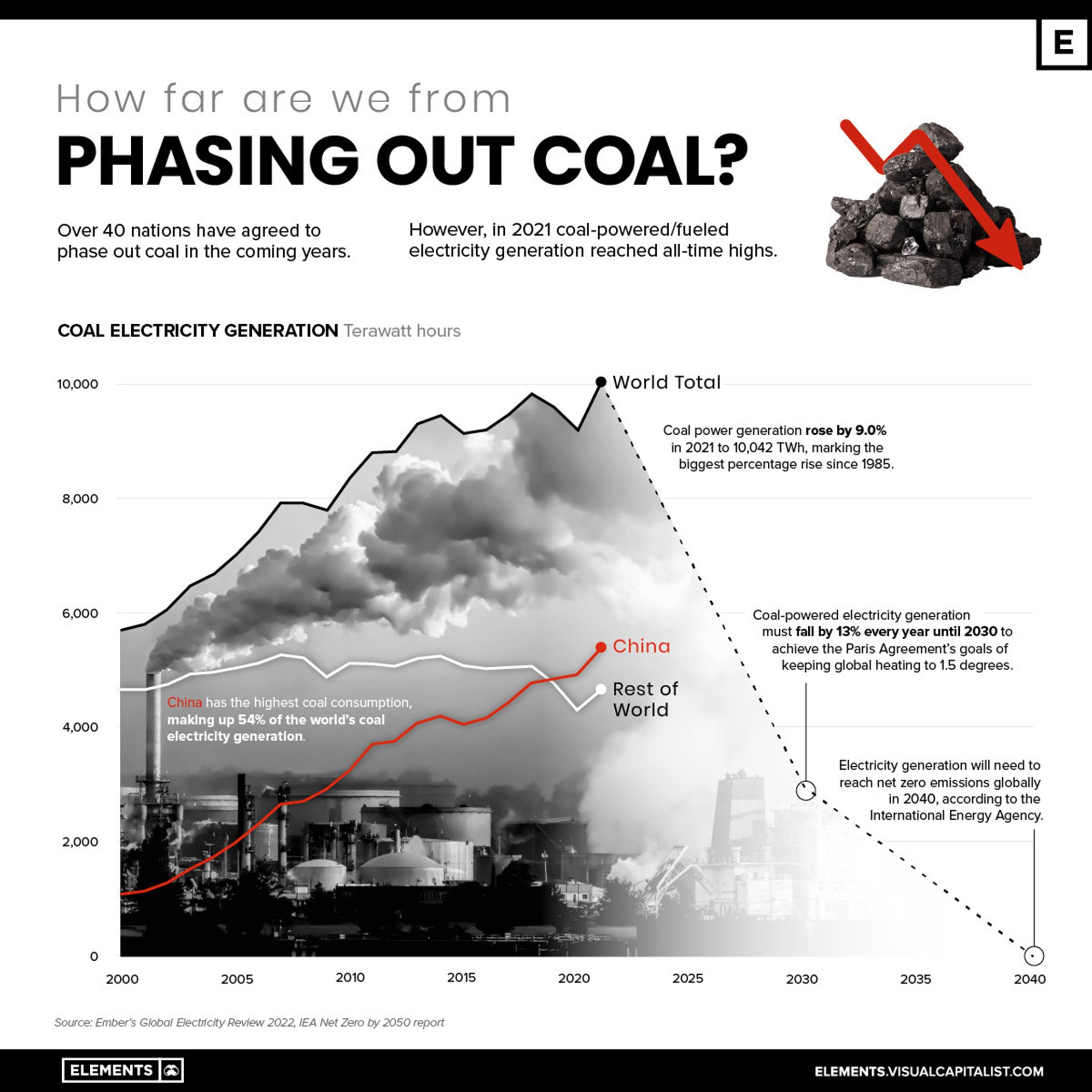
Source: World economic forum
“Steel and cement are an integral part of the modern world. Steel is found in everything, from major infrastructure to kitchenware, while cement, as the principal ingredient in concrete, is the most widely consumed resource in the world after water.
Steelmaking and cement production are both highly emission intensive. The need for continuous high-temperature heat to produce steel, cement and concrete requires huge amounts of energy, much of which is still dependent on fossil fuels. If the cement industry were a country, it would be the third largest emitter in the world.
Demand for cement and concrete is set to increase by more than one-third by 2050, when the global population is expected to reach 9.7 billion, 70 per cent of which will be living in cities. Even technologies that are driving the energy transition, such as wind turbines, require large amounts of steel and concrete.“
Source: IAP.unido.org
No. “Deep decarbonization of the steel and cement industries is one of the hardest climate change problems. Improvements in energy efficiency through technical advancements, and shifts in production methods are in pilot stages and there are currently no commercial-scale sites producing (near) zero-emission steel or cement.
In addition, Steel and cement plants generally have a lifespan of around 40 years, and investment cycles of 25 years. Windows of opportunity open only rarely, and retiring assets before the end of their productive life goes against the grain of traditional business and economic doctrine.
There are no commercially viable alternative materials to replace steel and cement. Timber is often touted as a ‘panacea’ –it is renewable, but there can still be so much carbon released during drying, processing and landfilling that it has a similar environmental impact to steel and concrete. Modern materials such as fibre-reinforced plastic have their own environmental challenges and would need to be produced at a much larger scale (and build up their associated supply chain) in order to meaningfully displace steel or concrete. All have some form of drawback – either have inferior technical performance, are equally (or more) polluting to produce, or are uneconomic or unavailable at the scale required.”
Source: IAP.unido.org
One of the great ironies of climate change is that as the planet warms, the technology that people need to stay cool will only make the climate hotter. By 2050, researchers expect the number of room air conditioners on Earth to quadruple to 4.5 billion, becoming at least as ubiquitous as cell phones are today. By the end of the century, greenhouse gas emissions from air conditioning will account for as much as a 0.5-degree Celsius rise in global temperatures.
The heart of the air conditioning paradox is both in how the devices work and what is happening to the climate. Essentially, air conditioners take heat from inside a house, or room, and then move that heat outside. They generally do so using chemical refrigerants, which, if leaked into the atmosphere, can have a global warming effect some 2,000 times more potent than carbon dioxide. Heatwaves will become only more frequent, prolonged, and deadly as the decades march on. That makes air-conditioning a life-saving adaptation to climate change which makes climate change worser. This has remained a difficult climate issue.
Source: World Economic Forum.
“The life cycle of plastic begins underground, where oil and gas are extracted from deep below the surface of the planet. These fossil fuels are then refined in facilities, using extreme temperatures and significant amount of water and energy, where they are transformed into pellets that are eventually melted and molded into things like water bottles, packaging, garbage bags and clothes.”
“And the widespread use of single-use plastic — the stuff we use once and then throw away — is only made worse by its disposal. Plastics do not break down once they’re thrown into nature. And, alarmingly, only around 9% plastic in the US is actually recycled, according to the Environmental Protection Agency — even the stuff you specifically threw into the recycle bin. Recycling alone will not solve this massive problem, This is why it’s so important to focus on reducing plastic use in the first place. 170 nations have pledged to "significantly reduce" use of plastics by 2030.”
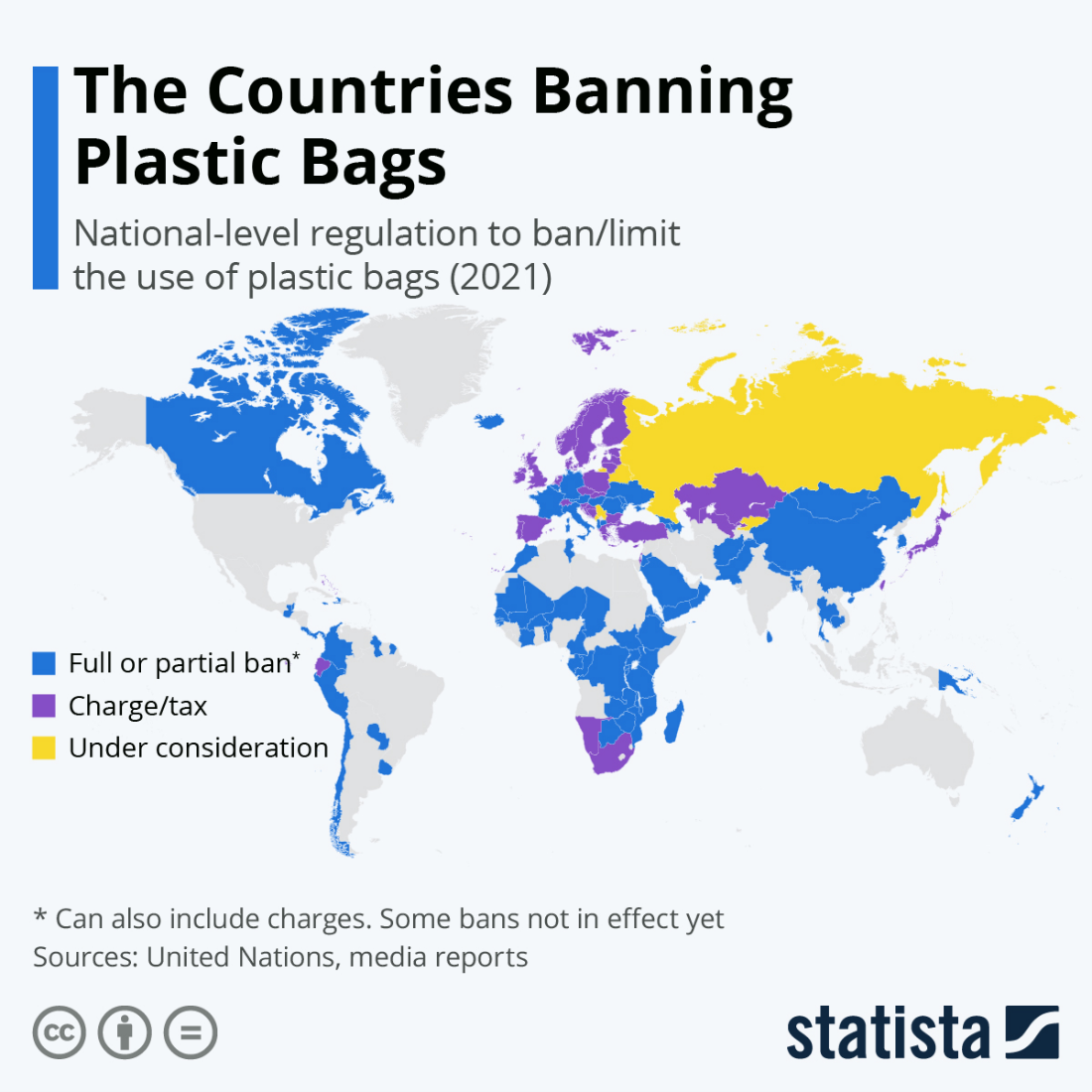
Source: EPA, CNN, Beyond Plastics
“Environmental, social, and corporate governance (ESG) is a socially responsible investing framework based on sustainable and ethical impacts. Investors are identifying, assessing, and addressing organizational objectives and activities ranging from the company’s carbon footprint and commitment to sustainability, to its workplace culture and commitment to diversity and inclusion, to its overall ethos regarding corporate risks and practices.”
“Although first coined in 2004, ESG has sparked a feeding frenzy in the financial sector over the past few years. Green finance is feted as a key tool in the fight against climate change. ESG related assets under management (AuM) is expected to increase to US$34trillion by 2026.”
“ESG scores are determined by third-party firms that have their own methodologies to identify a company’s ESG rating. Currently, there isn’t a process that is streamlined across the board, and different companies have their own way of determining a company’s ESG rating. The problem with ESG as an investment approach is the lack of standardized criteria for what makes an investment sustainable.”
“A recent paper from researchers at MIT and the University of Zurich, for instance, found very little consistency in the assessments of ESG rating agencies, making it tricky to evaluate the ESG performance of companies, funds, and portfolios. ESG investments are coming under a lot criticism for greenwashing.”
Source: CFAinstitute.org, Fortune
Yes, we can. Carbon removal can take numerous forms, from new technologies to land management practices. The big question is whether these approaches can deliver carbon removal at the scale needed in the coming decades. Here are a few methods, but each approach faces challenges and limitations.
Forests: Photosynthesis removes carbon dioxide naturally — and trees are especially good at storing carbon removed from the atmosphere by photosynthesis. Expanding, restoring and managing forests to encourage more carbon uptake can leverage the power of photosynthesis, converting carbon dioxide in the air into carbon stored in wood and soils. These approaches to remove CO2 through forests can be relatively inexpensive compared to other carbon removal options (generally less than $50 per metric ton) and yield cleaner water and air in the process.
Farms: Soils naturally store carbon, but agricultural soils are running a big deficit due to intensive use. Because agricultural land is so expansive, even small increases in soil carbon per acre could be impactful. Building soil carbon is good for farmers and ranchers, too, as it can increase soil health and crop yields. Integrating trees on farms can also remove carbon while providing other benefits, like shade and forage for livestock. Planting cover crops, using compost and draught resistant crops are ways to increase carbon capture.
Bio-energy with Carbon Capture and Storage (BECCS): Carbon Capture and Storage (BECCS) is the process of using biomass for energy in the industrial, power or transportation sectors; capturing its emissions before they are released back to the atmosphere; and then storing that captured carbon either underground or in long-lived products like concrete. However, it is far more complicated than planting trees or managing soils — and it doesn’t always work for the climate
Direct Air Capture: Direct air capture is the process of chemically scrubbing carbon dioxide directly from the ambient air, and then storing it either underground or in long-lived products. This new technology is similar to the carbon capture and storage technology used to capture emissions from sources like power plants and industrial facilities. The difference is that direct air capture removes excess carbon directly from the atmosphere, instead of capturing it at the source. But the technology remains costly and energy-intensive.
Carbon Mineralization: Some minerals naturally react with CO2, turning carbon from a gas into a solid. The process is commonly referred to as carbon mineralization or enhanced weathering, and it naturally happens very slowly, over hundreds or thousands of years. But scientists are figuring out how to speed up the carbon mineralization process, especially by enhancing the exposure of these minerals to CO2 in the air or ocean. There is more work to be done to map out cost-effective and prudent applications for scaled deployment.
Ocean-based Concepts: A number of ocean-based carbon removal concepts have been proposed to leverage the ocean’s capacity to store carbon and identify approaches beyond only land-based applications. However, nearly all of them are at early stages of development. Each approach aims to accelerate natural carbon cycles in the ocean. However, much is still unknown about the broader ecological impacts of these approaches and further research is needed to better understand potential risks before these approaches are pursued at any scale.
Source: WRI
Geoengineering: This is an option, albeit a dangerous one. It involves human tampering with the climate to reduce the effects of climate change, such as dispersing particles in the air, seeding clouds or using giant mirrors to reflect heat back into space. The long term knock on effects of such methods are unknown and rife with destructive potential too, so it is best to be wary.
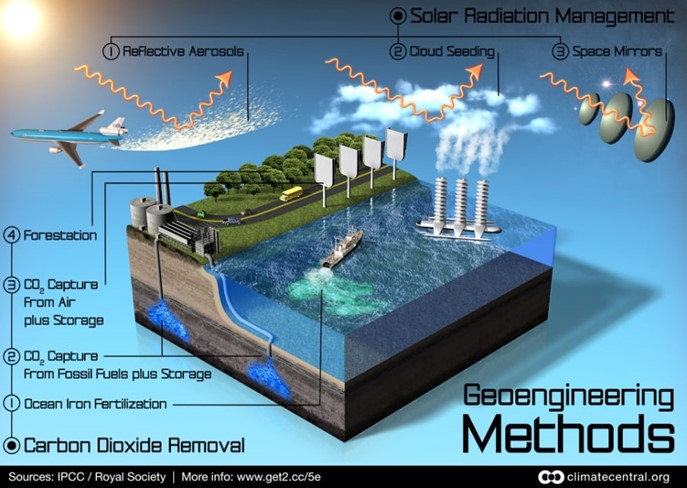
Source: Climate Central